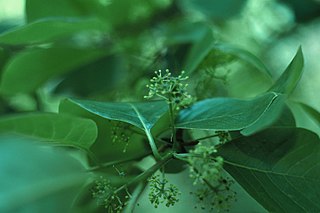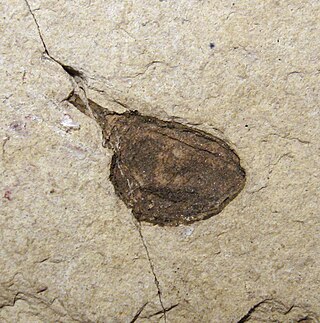
Tupelo, genus Nyssa, is a small genus of deciduous trees with alternate, simple leaves. It is sometimes included in the subfamily Nyssoideae of the dogwood family, Cornaceae, but is placed by other authorities in the family Nyssaceae. In the APG IV system, it is placed in Nyssaceae.

Cornus is a genus of about 30–60 species of woody plants in the family Cornaceae, commonly known as dogwoods, which can generally be distinguished by their blossoms, berries, and distinctive bark. Most are deciduous trees or shrubs, but a few species are nearly herbaceous perennial subshrubs, and some species are evergreen. Several species have small heads of inconspicuous flowers surrounded by an involucre of large, typically white petal-like bracts, while others have more open clusters of petal-bearing flowers. The various species of dogwood are native throughout much of temperate and boreal Eurasia and North America, with China, Japan, and the southeastern United States being particularly rich in native species.
Paleontology or palaeontology is the study of prehistoric life forms on Earth through the examination of plant and animal fossils. This includes the study of body fossils, tracks (ichnites), burrows, cast-off parts, fossilised feces (coprolites), palynomorphs and chemical residues. Because humans have encountered fossils for millennia, paleontology has a long history both before and after becoming formalized as a science. This article records significant discoveries and events related to paleontology that occurred or were published in the year 1954.
Paleontology or palaeontology is the study of prehistoric life forms on Earth through the examination of plant and animal fossils. This includes the study of body fossils, tracks (ichnites), burrows, cast-off parts, fossilised feces (coprolites), palynomorphs and chemical residues. Because humans have encountered fossils for millennia, paleontology has a long history both before and after becoming formalized as a science. This article records significant discoveries and events related to paleontology that occurred or were published in the year 1940.

Dillhoffia is an extinct monotypic genus of flowering plant with a single species, Dillhoffia cachensis known from Ypresian age Eocene fossils found in British Columbia, Canada, and Washington, USA. The genus and species were described from fifteen specimens found in an unnamed formation belonging to the Kamloops group shales; and two specimens from the Klondike Mountain Formation. The unnamed formation outcrops at the McAbee Fossil Beds near Cache Creek, BC, which is designated the type locality while the two U.S. specimens were recovered from the Tom Thumb Tuff member of the Klondike Mountain Formation in Republic, Washington. It is of interest to note that of the Okanagan highlands fossil sites Dillhoffia is only known from two locations, and is absent or has not been identified from the others.
Acer clarnoense is an extinct maple species in the family Sapindaceae described from a series of isolated fossil leaves and samaras. The species is known from the late Eocene sediments exposed in the state of Oregon in the US. It is one of several extinct species placed in the living section Macrantha.
Cornus piggae is an extinct species of dogwood known from fossil fruits found in Late Paleocene sediments exposed in the US state of North Dakota. C. piggae is one of three extinct species placed in the Cornus subgenus Cornus based on fossil fruit morphology. The other two species, C. ettingshausenii and C. multilocularis are known from pyritized fruits found in sediments of the London Clay in England. C. piggae is the only North American fruit species yet described and is also the oldest described species in Cornus subgenus Cornus.

Eucommia montana is an extinct species of flowering plant in the family Eucommiaceae. E. montana is known from fossil fruits found in Eocene deposits of the northwestern United States southeastern British Columbia south to Oregon and east to Montana and Colorado. E. montana is one of five described fossil species from North America assigned to the modern genus Eucommia. The other species are E. constans, E. eocenica, E. jeffersonensis, and E. rowlandii.
Eucommia jeffersonensis is an extinct species of flowering plant in the family Eucommiaceae. It is known from a fossil fruit found in latest Eocene deposits of Oregon, United States. E. jeffersonensis is one of five described fossil species from North America assigned to the modern genus Eucommia. The other species are E. constans, E. eocenica, E. montana, and E. rolandii.
Taxus masonii is an extinct species of conifer in the yew family, Taxaceae, solely known from the middle Eocene sediments exposed in north central Oregon. The species was first described from a series of isolated fossil seeds in chert.
Torreya clarnensis is an extinct species of conifer in the yew family Taxaceae solely known from the middle Eocene sediments exposed in north central Oregon. The species was first described from a series of isolated fossil seeds in chert.
Diploporus is an extinct genus of conifers in the yew family Taxaceae, containing the single species Diploporus torreyoides known from the middle Eocene of north central Oregon and the Late Paleocene of south central North Dakota. The species was first described from a series of isolated fossil seeds in chert.
Actinidia oregonensis is an extinct species of flowering plants in the kiwifruit family, Actinidiaceae, solely known from the middle Eocene sediments exposed in north-central Oregon. The species was first described from a series of isolated fossil seeds in chert.
Rhus rooseae is an extinct species of flowering plants in the sumac family, Anacardiaceae, solely known from the middle Eocene sediments exposed in north central Oregon. The species was first described from a series of isolated fossil seeds in chert.
Paleopanax is an extinct genus of flowering plant in the Ginseng and Ivy family, Araliaceae, containing the single species Paleopanax oregonensis. The species is solely known from the middle Eocene sediments exposed in north central Oregon and was first described from a series of isolated fossil fruits in siltstones.
Coryloides is an extinct genus of flowering plants in the hazelnut family, Betulaceae, containing the single species Coryloides hancockii. The species is solely known from the middle Eocene sediments exposed in north central Oregon and was first described from a series of isolated fossil nuts in cherts.
Kardiasperma is an extinct genus of flowering plants in the hazelnut family, Betulaceae, containing the single species Kardiasperma parvum. The species is solely known from the middle Eocene sediments exposed in north central Oregon and was first described from a series of isolated fossil nuts in cherts.
Nyssa spatulata is an extinct species of flowering plant in the tupelo family, Nyssaceae known from the middle Eocene sediments exposed in north central Oregon. The species was first described from a series of isolated fossil seeds in chert.

Pteronepelys, sometimes known as the winged stranger, is an extinct genus of flowering plant of uncertain affinities, which contains the one species, Pteronepelys wehrii. It is known from isolated fossil seeds found in middle Eocene sediments exposed in north central Oregon and Ypresian-age fossils found in Washington, US.

Fagus langevinii is an extinct species of beech in the family Fagaceae. The species is known from fossil fruits, nuts, pollen, and leaves found in the early Eocene deposits of South central British Columbia, and northern Washington state, United States.





